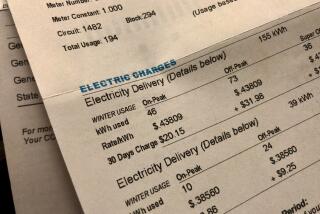Entrepreneurs Are Changing the Shape of Electric Utility Industry
- Share via
America needs to encourage competition within its electricity market. The regulated monopolies’ inaccurate projections of the demand for electricity have forced the cancellation of at least 180 proposed power plants--more than the combined electric generating capacity of Texas and California.
In addition, the construction of over-budget nuclear reactors has raised rates in many states. And, at least a half dozen power companies across the country teeter near bankruptcy.
The answer to the problem lies with energy entrepreneurs, who exist today because the marketplace demands alternatives to the utility monopolies’ power.
But the independents needed an act of Congress to eliminate a 70-year-old requirement that only regulated utilities could sell electricity to consumers. And because of that legislation, the electricity market’s monopoly structure is opening to competition, a shift that promises to lower costs, spur technological innovation and foster economic development.
The emerging independent power producers--who co-generate heat and electricity, burn wastes and harness the sun, wind, geothermal steam and hydropower--are beginning to comprise one of the nation’s fastest growing industries.
Although dismissed only a few years ago as backyard tinkerers with limited potential, these electric entrepreneurs now form a multibillion-dollar industry that includes hundreds of new firms as well as growing units within some of America’s largest corporations.
Legislative change came in the late 1970s, when the Carter Administration and Congress sought ways to reduce U.S. dependence on oil from the Organization of Petroleum Exporting Countries by encouraging industries and individuals to invest in co-generation systems, windmills, hydroelectric facilities and other small power technologies.
In 1978, Congress approved the Public Utility Regulatory Policies Act, which allows independents to sell electricity to their utilities on favorable terms and to interconnect with the utility grid and buy back-up power at a reasonable cost.
As the legislation was being debated in Congress, the utilities didn’t take the independent producers seriously, immodestly assuming that only utility engineers could construct and operate electric generators. Instead, the utilities focused their lobbying efforts on other issues such as rate reform.
But after the law was signed and new businesses began to challenge their monopolies, power companies filed a series of lawsuits to block the law’s implementation.
The challenges even reached the Supreme Court, which in May, 1983, unanimously upheld the legislation, ruling that it “provides a significant incentive to the development of co-generation and small power production, and that ratepayers and the nation as a whole would benefit from the decreased reliance on scarce fossil fuels and the more efficient use of energy.”
In California, perhaps the only state where local officials have fully implemented that legislation and exposed the utility industry to some competition, the results testify to the open market’s effectiveness in stimulating development. In January, 1982, independents supplied only 100 megawatts of the state’s electricity.
Three years later, they had installed 1,659 megawatts of power plants, about the equivalent of two medium-sized nuclear reactors, and were constructing another 9,165 megawatts, enough to boost the output of independents to a whopping 25% of California’s current electrical capacity.
Independent power producers are not limited to the West Coast, however. Similar growth is occuring in Texas, Michigan, Florida, New York, New Hampshire and in other pockets across the country where utility rates are high.
In Houston, for example, co-generators added 1,300 megawatts, more than a large nuclear reactor, between 1982 and 1984. Later in this decade, they plan to supply almost 6,000 megawatts of electricity, more than half of what is needed to supply power to metropolitan Houston.
Independents claim that utilities will never again build centralized power plants because entrepreneurs can supply electric capacity faster, safer, cleaner and more economically than can utility monopolies.
They contrast, for example, the rise of independents with major utilities’ projects such as the construction of the Diablo Canyon reactors: Electric entrepreneurs installed as much new capacity in less than one-fifth the time, without an eightfold increase in the planned budget--and without protests from environmentalists.
Moreover, the new diversity promises a more reliable and economical approach to supplying enough energy in an era when the demand for electricity is uncertain.
Most utilities still claim that electric entrepreneurs and alternative energy technologies have very limited potential. In fact, the program at the utility industry’s 1984 convention failed to even mention the new multibillion-dollar enterprise.
Thoughtful Executives
The more thoughtful utility executives, however, are slowly changing their minds. They find that buying electricity from independents is more economical than building their own central power stations.
It makes more sense--many firms have admitted publicly--for entrepreneurs to risk their capital than for the power company to finance expensive new facilities.
Independent power suppliers enjoy growing support. Wall Street investors, for example, prefer innovative businesses to utilities that continue to build large power plants. The blend of efficiency and dispersed generators also pleases environmentalists, who have been trying to warn Americans of the dangers of acid rain and nuclear wastes. And, the diversity of growing companies also promises workers more jobs than similar investments in large power plants.
More to Read
Inside the business of entertainment
The Wide Shot brings you news, analysis and insights on everything from streaming wars to production — and what it all means for the future.
You may occasionally receive promotional content from the Los Angeles Times.










